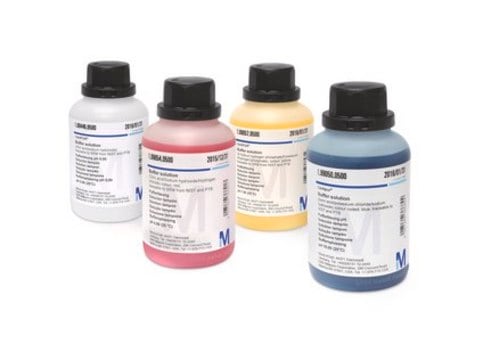1.07294
Buffer solution
di-sodium hydrogen phosphate/potassium dihydrogen phosphate, traceable to NIST, traceable to PTB, pH 6.88 (20 °C), Certipur®
Sinónimos:
di-sodium hydrogen phosphate/potassium dihydrogen phosphate buffer, pH 6.88 calibration standard solution
About This Item
Productos recomendados
grado
certified reference material
Nivel de calidad
Agency
traceable to NIST
traceable to PTB
Línea del producto
Certipur®
composición
di-sodium hydrogen phosphate/potassium dihydrogen phosphate
pH
6.88 (20 °C)
aplicaciones
environmental
food and beverages
general analytical
industrial qc
pharmaceutical
Formato
mixture
temp. de almacenamiento
15-25°C
Descripción general
The ready-to-use Certipur® buffer solutions are prepared gravimetrically in our ISO/IEC 17025 accredited calibration laboratory from high-purity salts, acids and bases diluted in high-purity water. All balances are regularly calibrated with analytical weight sets traceable to primary standard reference materials from NIST and PTB. The pH-value is measured to the highest precision using a combined glass electrode after 5-point calibration (according to DIN 19268) against reference buffer solutions (according to DIN 19266, IUPAC, NIST, Ph.Eur. and USP).
Download your certificate at http://www.sigma-aldrich.com to view certified values, including uncertainty and expiry date.
Características y beneficios
- Compliant: Produced according to EP and USP guidelines
- Secure: Tested in our ISO 17025 accredited calibration laboratory
- Ready for audits: Detailed certificate of analysis for every product
- Convenient: Simply open the pack for quick, accurate pH calibration
Información legal
Opcional
Código de clase de almacenamiento
12 - Non Combustible Liquids
Clase de riesgo para el agua (WGK)
nwg
Punto de inflamabilidad (°F)
Not applicable
Punto de inflamabilidad (°C)
Not applicable
Certificados de análisis (COA)
Busque Certificados de análisis (COA) introduciendo el número de lote del producto. Los números de lote se encuentran en la etiqueta del producto después de las palabras «Lot» o «Batch»
¿Ya tiene este producto?
Encuentre la documentación para los productos que ha comprado recientemente en la Biblioteca de documentos.
Los clientes también vieron
Nuestro equipo de científicos tiene experiencia en todas las áreas de investigación: Ciencias de la vida, Ciencia de los materiales, Síntesis química, Cromatografía, Analítica y muchas otras.
Póngase en contacto con el Servicio técnico











